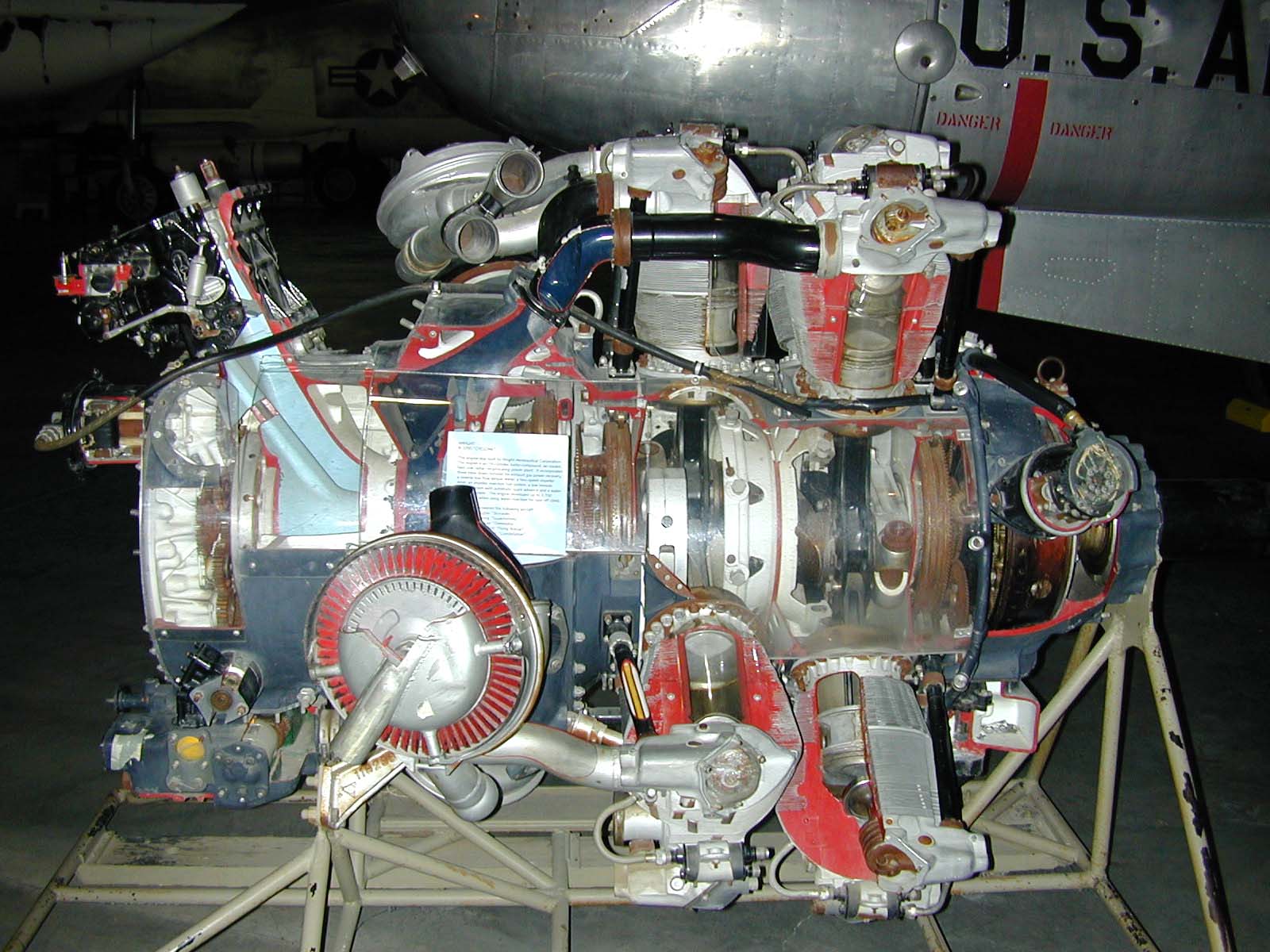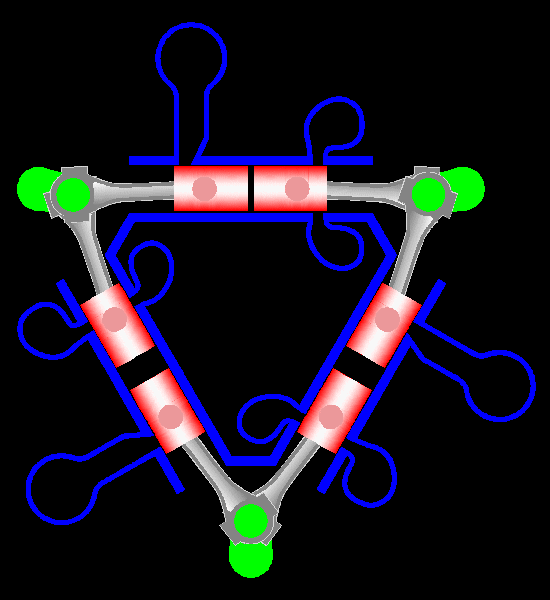|
Turbo-compound
A turbo-compound engine is a reciprocating engine that employs a turbine to recover energy from the exhaust gases. Instead of using that energy to drive a turbocharger as found in many high-power aircraft engines, the energy is instead sent to the output shaft to increase the total power delivered by the engine. The turbine is usually mechanically connected to the crankshaft, as on the Wright R-3350 Duplex-Cyclone, but electric and hydraulic power recovery systems have been investigated as well. As this recovery process does not increase fuel consumption, it has the effect of reducing the specific fuel consumption, the ratio of fuel use to power. Turbo-compounding was used for commercial airliners and similar long-range, long-endurance roles before the introduction of turbojet engines. Examples using the Duplex-Cyclone include the Douglas DC-7B and Lockheed L-1049 Super Constellation, while other designs did not see production use. Concept Most piston engines have a hot exhau ... [...More Info...] [...Related Items...] OR: [Wikipedia] [Google] [Baidu] |
Lockheed L-1049 Super Constellation
The Lockheed L-1049 Super Constellation is an American aircraft, a member of the Lockheed Constellation aircraft line. The L-1049 was Lockheed's response to the successful Douglas DC-6 airliner, first flying in 1950. The aircraft was also produced for both the United States Navy as the WV / R7V and U.S. Air Force as the C-121 for transport, electronics, and airborne early warning and control aircraft. Development Beginning in 1943, Lockheed planned stretched variants of the Constellation family. The first was the L-049 with a fuselage lengthened by 13 feet (4 meters) and the second the L-749 stretched 18 feet (5.5 meters). Douglas launched a stretched version of its DC-6 airliner as a cargo transport, designated DC-6A, for both military and civilian operators. Douglas was soon to launch a passenger version (the DC-6B) of this new aircraft. The DC-6B could carry 23 more passengers than Lockheed's current production L-749 Constellation. In 1950, Lockheed had repurchased the ... [...More Info...] [...Related Items...] OR: [Wikipedia] [Google] [Baidu] |
Napier Nomad
The Napier Nomad is a British diesel aircraft engine designed and built by Napier & Son in 1949. They combined a piston engine with a turbine to recover energy from the exhaust and thereby improve fuel economy. Two versions were tested, the complex Nomad I which used two propellers, each driven by the mechanically independent stages, and the Nomad II, using the turbo-compound principle, coupled the two parts to drive a single propeller. The Nomad II had the lowest specific fuel consumption figures seen up to that time. Despite this the Nomad project was cancelled in 1955 having spent £5.1 million on development, as most interest had passed to turboprop designs. Design and development In 1945 the Air Ministry asked for proposals for a new class engine with good fuel economy. Curtiss-Wright was designing an engine of this sort of power known as the turbo-compound engine, but Sir Harry Ricardo, one of Britain's great engine designers, suggested that the most economical ... [...More Info...] [...Related Items...] OR: [Wikipedia] [Google] [Baidu] |
Wright R-3350 Duplex-Cyclone
The Wright R-3350 Duplex-Cyclone is an American twin-row, supercharged, air-cooled, radial aircraft engine with 18 cylinders displacing nearly . Power ranged from 2,200 to over 3,700 hp (1,640 to 2,760 kW), depending on the model. Developed before World War II, the R-3350's design required a long time to mature before finally being used to power the Boeing B-29 Superfortress. After the war, the engine had matured sufficiently to become a major civilian airliner design, notably in its turbo-compound forms, and was used in the Lockheed L-1049 Super Constellation airliners into the 1990s. The engine is commonly used on Hawker Sea Fury and Grumman F8F Bearcat Unlimited Class Racers at the Reno Air Races. Its main rival was the , Pratt & Whitney R-4360 Wasp Major, first run some seven years after the Duplex-Cyclone's beginnings. Design and development In 1927, Wright Aeronautical introduced its famous "Cyclone" engine, which powered a number of designs in the 1930s. ... [...More Info...] [...Related Items...] OR: [Wikipedia] [Google] [Baidu] |
Rolls-Royce Crecy
The Rolls-Royce Crecy was a British experimental two-stroke, 90-degree, V12, liquid-cooled aero-engine of 1,593.4 cu.in (26.11 L) capacity, featuring sleeve valves and direct petrol injection. Initially intended for a high-speed "sprint" interceptor fighter, the Crecy was later seen as an economical high-altitude long-range powerplant. Developed between 1941 and 1946, it was among the most advanced two-stroke aero-engines ever built. The engine never reached flight trials and the project was cancelled in December 1945, overtaken by the progress of jet engine development. The engine was named after the Battle of Crécy, after Rolls-Royce chose battles as the theme for naming their two-stroke aero engines. Rolls-Royce did not develop any other engines of this type. Design and development Origins Sir Henry Tizard, Chairman of the Aeronautical Research Committee (ARC), was a proponent of a high-powered "sprint" engine for fighter aircraft and had foreseen the need for such a ... [...More Info...] [...Related Items...] OR: [Wikipedia] [Google] [Baidu] |
Napier Deltic
The Napier Deltic engine is a British opposed-piston valveless, supercharged uniflow scavenged, two-stroke diesel engine used in marine and locomotive applications, designed and produced by D. Napier & Son. Unusually, the cylinders were disposed in a three-bank triangle, with a crankshaft at each corner of the triangle. The term Deltic (meaning "in the form of the Greek letter (capital) delta") is used to refer to both the Deltic E.130 opposed-piston, high-speed diesel engine and the locomotives produced by English Electric using these engines, including its demonstrator locomotive named ''DELTIC'' and the production version for British Railways, which designated these as ( TOPS) Class 55. A single, half-sized, turbocharged Deltic power unit also featured in the English Electric-built Type 2 locomotive, designated as the Class 23. Both locomotive and engine became better known as the "Baby Deltic". History and design The Deltic story began in 1943 when the British Admir ... [...More Info...] [...Related Items...] OR: [Wikipedia] [Google] [Baidu] |
Specific Fuel Consumption (shaft Engine)
Brake-specific fuel consumption (BSFC) is a measure of the fuel efficiency of any prime mover that burns fuel and produces rotational, or shaft power. It is typically used for comparing the efficiency of internal combustion engines with a shaft output. It is the rate of fuel consumption divided by the power produced. In traditional units, it measures fuel consumption in pounds per hour divided by the brake horsepower, lb/(hp⋅h); in SI units, this corresponds to the inverse of the units of specific energy, kg/J = s2/m2. It may also be thought of as power- specific fuel consumption, for this reason. BSFC allows the fuel efficiency of different engines to be directly compared. The term "brake" here as in " brake horsepower" refers to a historical method of measuring torque (see Prony brake). The BSFC calculation (in metric units) To calculate BSFC, use the formula : BSFC = \frac where: :'' r '' is the fuel consumption rate in grams per second (g/s) :'' P '' is the power pro ... [...More Info...] [...Related Items...] OR: [Wikipedia] [Google] [Baidu] |
Formula 1
Formula One (also known as Formula 1 or F1) is the highest class of international racing for open-wheel single-seater formula racing cars sanctioned by the Fédération Internationale de l'Automobile (FIA). The World Drivers' Championship, which became the FIA Formula One World Championship in 1981, has been one of the premier forms of racing around the world since its inaugural season in 1950. The word ''formula'' in the name refers to the set of rules to which all participants' cars must conform. A Formula One season consists of a series of races, known as ''Grands Prix'', which take place worldwide on both purpose-built circuits and closed public roads. A points system is used at Grands Prix to determine two annual World Championships: one for drivers, the other for constructors. Each driver must hold a valid Super Licence, the highest class of racing licence issued by the FIA. The races must run on tracks graded "1" (formerly "A"), the highest grade-rating issued ... [...More Info...] [...Related Items...] OR: [Wikipedia] [Google] [Baidu] |
Scania AB
Scania AB is a major Swedish manufacturer headquartered in Södertälje, focusing on commercial vehicles—specifically heavy lorries, trucks and buses. It also manufactures diesel engines for heavy vehicles as well as marine and general industrial applications. Scania was formed in 1911 through the merger of Södertälje-based Vabis and Malmö-based Maskinfabriks-aktiebolaget Scania. Since 1912, the company has been re-located again to Södertälje after the merger. Today, Scania has production facilities in Sweden, France, the Netherlands, Thailand, China, India, Argentina, Brazil, Poland, Russia and Finland. In addition, there are assembly plants in ten countries in Africa, Asia and Europe. Scania's sales and service organisation and finance companies are worldwide. In 2012, the company employed approximately 42,100 people around the world. Scania was listed on the NASDAQ OMX Stockholm stock exchange from 1996 to 2014. The company is a subsidiary of Traton, part of t ... [...More Info...] [...Related Items...] OR: [Wikipedia] [Google] [Baidu] |
Formula One Engines
Since its inception in 1947, Formula One has used a variety of engine regulations. "Formulae" limiting engine capacity had been used in Grand Prix racing on a regular basis since after World War I. The engine formulae are divided according to era. Operation Formula One currently uses 1.6 litre four-stroke turbocharged 90 degree V6 double-overhead camshaft (DOHC) reciprocating engines. They were introduced in 2014 and have been developed over the subsequent seasons. The power a Formula One engine produces is generated by operating at a very high rotational speed, up to 20,000 revolutions per minute (rpm). However, they are electronically limited to 15,000 as of 2021 season. This contrasts with road car engines of a similar size, which typically operate at less than 6,000 rpm. The basic configuration of a naturally aspirated Formula One engine had not been greatly modified since the 1967 Ford Cosworth DFV and the mean effective pressure had stayed at around 14 ba ... [...More Info...] [...Related Items...] OR: [Wikipedia] [Google] [Baidu] |
Detroit Diesel
Detroit Diesel Corporation (DDC) is an American diesel engine manufacturer headquartered in Detroit, Michigan, United States. It is a subsidiary of Daimler Truck North America, which is itself a wholly owned subsidiary of the mulitinational Daimler Truck AG. The company manufactures heavy-duty engines and chassis components for the on-highway and vocational commercial truck markets. Detroit Diesel has built more than 5 million engines since 1938, more than 1 million of which are still in operation worldwide. Detroit Diesel's product line includes engines, axles, transmissions, and a Virtual Technician service. Detroit engines, transmissions, and axles are used in several models of truck manufactured by Daimler Truck North America. Divisions Detroit Diesel consists of manufacturing operations of axles, transmissions and diesel engines for on-highway only, which is owned by Daimler Truck AG. The former off-highway division was sold to MTU Friedrichshafen in 2006 and subsequent ... [...More Info...] [...Related Items...] OR: [Wikipedia] [Google] [Baidu] |
Turboprop
A turboprop is a turbine engine that drives an aircraft propeller. A turboprop consists of an intake, reduction gearbox, compressor, combustor, turbine, and a propelling nozzle. Air enters the intake and is compressed by the compressor. Fuel is then added to the compressed air in the combustor, where the fuel-air mixture then combusts. The hot combustion gases expand through the turbine stages, generating power at the point of exhaust. Some of the power generated by the turbine is used to drive the compressor and electric generator. The gases are then exhausted from the turbine. In contrast to a turbojet or turbofan, the engine's exhaust gases do not provide enough energy to create significant thrust, since almost all of the engine's power is used to drive the propeller. Technological aspects Exhaust thrust in a turboprop is sacrificed in favor of shaft power, which is obtained by extracting additional power (beyond that necessary to drive the compressor) from turb ... [...More Info...] [...Related Items...] OR: [Wikipedia] [Google] [Baidu] |






